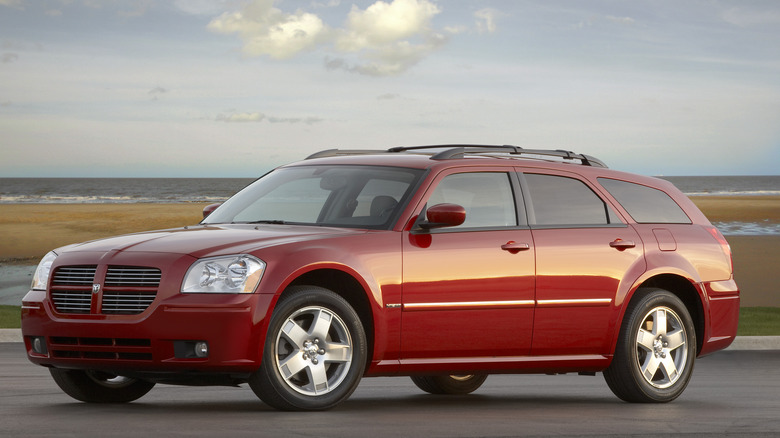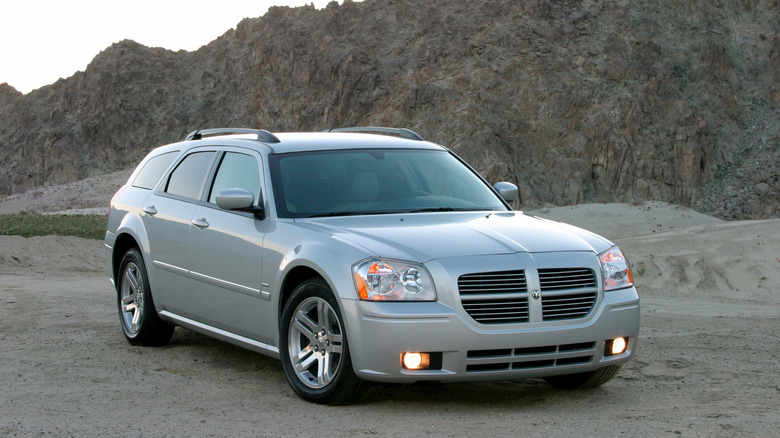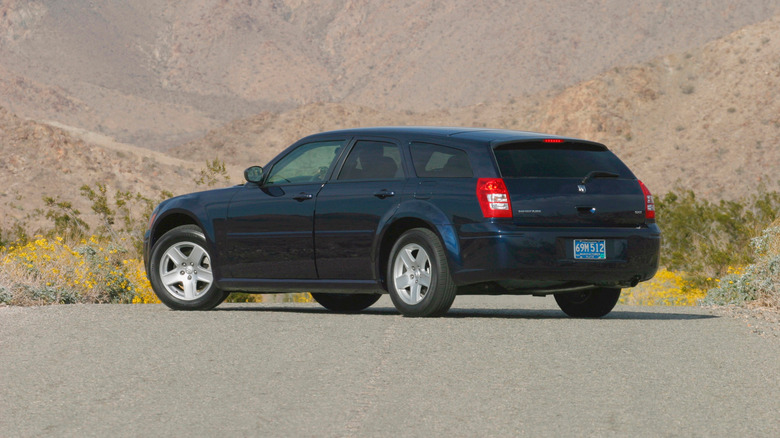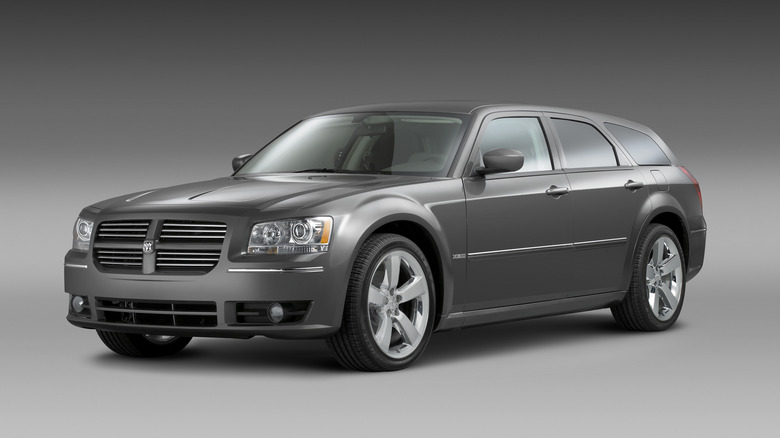Here's Why Dodge Discontinued The Magnum
Among car historians, the Dodge Magnum often has the image of the underachieving younger sibling of the far more well-received Dodge Charger. This particular line of cars has had it rough since birth, with the first of its kind being a failed 70s Dodge Magnum that many probably didn't know existed. Despite the relative lack of popularity at its origin, the Magnum brand managed to live on in various forms in countries like Brazil and Mexico up until the late 80s. Miraculously, it was revived once again in the mid-to-late-00s.
Whereas previous models had failed to gain the icon status Dodge was hoping for, the 2005 Dodge Magnum was different. Eschewing its predecessors' mid-size 2-door coupe design, the new Magnum was positioned as a full-size station wagon boasting plenty of power with its V-6 and V-8 engine options. The fresh iteration of the car was positively received, with Car and Driver even selecting it out of numerous nominees for its list of the 10 best car models of 2005. For several years afterward, the Magnum was a mainstay of Dodge's lineup until it was abruptly discontinued in 2008.
With such a promising redesign, some consumers no doubt still wonder why the Magnum's revival was cut short. Of course, commercial viability was a key factor in Dodge's decision, but the main reasons behind the model's death have to do with certain major changes in the greater industry that were happening around the same time.
The Dodge Magnum was a wagon in an SUV world
While Dodge's effort to completely reinvent the Dodge Magnum for its 2005 rebirth was a solid decision, it can be argued that the form this pivot ultimately took barred the Magnum from ever reaching its full potential. Simply put, the Magnum was a high-quality station wagon released at a time when station wagons were falling further and further out of vogue.
The popularity of station wagons began to decline rapidly during the 1990s, especially in the United States. What was once considered the quintessential family car design was now struggling to go toe-to-toe with the increasingly popular realm of modern SUVs and crossovers. Advancements in these types of cars meant that they boasted a comparable amount of roominess, a higher driver's seat, and a sleeker design. In time, it became clear that the surge of the SUV, in particular, wasn't just a passing trend — it was managing to make the once-beloved wagon completely redundant in the eyes of many Americans.
By 2005, much of the damage had already been done. SUVs had proven that they weren't going anywhere anytime soon, and wagons were struggling to maintain a diminishing piece of the pie. In some ways, the revival of the Magnum was one of the final attempts to breathe life into the wagon space, with its refined curved design and emphasis on power and versatility. Dodge even attempted to position the car as a "sports tourer" rather than a wagon. No matter how solid of a vehicle it was, however, the Magnum was powerless against the changing tide of the industry.
Chrysler Group faced a struggling market in 2006
As the rise of SUVs and crossovers to overtake station wagons illustrates, the car market of the 2000s was evolving to reflect the future of the industry. However, in other ways, the market was backsliding. 2006 proved to be a difficult year for America-based car manufacturers, as they reckoned with worsening economic conditions, gas prices going up, and ferocious competition from foreign brands.
Chrysler Corporation, the parent company of Dodge, was particularly hit hard by the crisis. Per a report from WardsAuto, Chrysler weathered a $1.4 billion loss in 2006. Together with Ford and General Motors, which also posted overall losses, the three major manufacturers only managed to deliver roughly 8,868,372 cars that year, accounting for nearly 54% of the overall market share. A struggle of this degree hadn't been seen in the industry for well over a decade.
In accordance with the weak market, Chrysler — and Dodge — had to adapt. The company's operations were constricted. There was little room for overspending or manufacturing products that weren't hot commodities. "We have to move now to adjust the way our company looks and acts to reflect a smaller market," Tom LaSorda, Vice Chairman and President of Chrysler, said in the press release announcing the discontinuation of the Ford Magnum. "That means a cost base that is right-sized and an appropriate level of plant utilization."
The Magnum wasn't meeting Dodge's standards
Unfortunately, the favoritism of SUVs and crossovers over station wagons and the declining state of the auto industry gave the revived Dodge Magnum no small amount of trouble from the start — and those obstacles resulted in sales that were solid but not solid enough. While it garnered a positive reception at the time of its release, the car apparently wasn't meeting Chrysler's commercial standards. To some extent, the writing was on the wall even before the announcement of its discontinuation was made.
In the 2007 press release announcing the Magnum's discontinuation, the company cited the smaller car market, the commercial underperformance of the vehicle, and pressure from dealers to pivot away from the model. "These actions reflect our new customer-driven philosophy and allow us to focus our resources on new, more profitable and appealing products," Jim Press, Vice Chairman and President of Chrysler, stated in the press release. "Further, these product actions are all in response to dealer requests."
The Magnum wasn't the only model on the chopping block, either. Alongside the unfortunate station wagon, the Chrysler Pacifica, Chrysler Crossfire, and the convertible Chrysler PT Cruiser were all axed. While some, like the Pacifica, have since seen a return in recent years, the Magnum remains dormant. As for whether this legacy Dodge brand will ever be revived, that remains to be seen.



